
カタログの抜粋
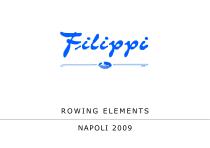
ROWING ELEMENTS
カタログの1ページ目を開く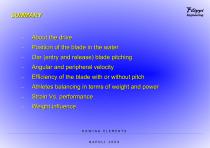
Position of the blade in the water Oar (entry and release) blade pitching Angular and peripheral velocity Efficiency of the blade with or without pitch Athletes balancing in terms of weight and power Weight influence
カタログの2ページ目を開く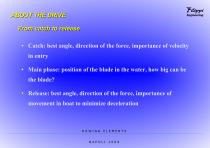
From catch to release • Catch: best angle, direction of the force, importance of velocity in entry • Main phase: position of the blade in the water, how big can be the blade? • Release: best angle, direction of the force, importance of movement in boat to minimize deceleration
カタログの3ページ目を開く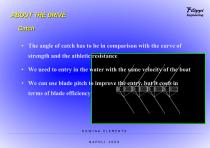
Catch • The angle of catch has to be in comparison with the curve of strength and the athletic resistance • We need to entry in the water with the same velocity of the boat • We can use blade pitch to improve the entry, but it costs in terms of blade efficiency
カタログの4ページ目を開く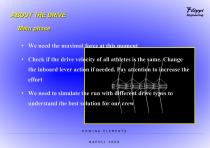
Main phase • We need the maximal force at this moment • Check if the drive velocity of all athletes is the same. Change the inboard lever action if needed. Pay attention to increase the effort • We need to simulate the run with different drive types to understand the best solution for our crew
カタログの5ページ目を開く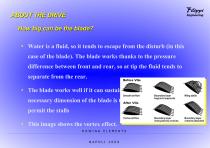
How big can be the blade? • Water is a fluid, so it tends to escape from the disturb (in this case of the blade). The blade works thanks to the pressure difference between front and rear, so at tip the fluid tends to separate from the rear. • The blade works well if it can sustain the power of rower, so the necessary dimension of the blade is the minimum that doesn't permit the stalls • This image shows the vortex effect. ROWING
カタログの6ページ目を開く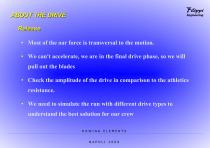
Release • Most of the oar force is transversal to the motion. • We can't accelerate, we are in the final drive phase, so we will pull out the blades • Check the amplitude of the drive in comparison to the athletics resistance. • We need to simulate the run with different drive types to understand the best solution for our crew ROWING
カタログの7ページ目を開く
POSITION OF THE BLADE IN THE WATER • Use the minimum part of the shaft in the water • The blade requires to be over 2cm in the water, better if parallel to the water. Check the oarlock-water distance to obtain it • Use typical 22cm(h) oarlock-water distance to start setting trials Filippi Engineering
カタログの8ページ目を開く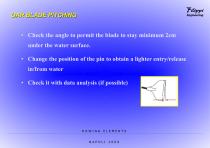
• Check the angle to permit the blade to stay minimum 2cm under the water surface. • Change the position of the pin to obtain a lighter entry/release in/from water • Check it with data analysis (if possible)
カタログの9ページ目を開く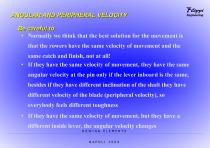
ANGULAR AND PERIPHERAL VELOCITY Filippi Engineering Be careful to • Normally we think that the best solution for the movement is that the rowers have the same velocity of movement and the same catch and finish, not at all! • If they have the same velocity of movement, they have the same angular velocity at the pin only if the lever inboard is the same, besides if they have different inclination of the shaft they have different velocity of the blade (peripheral velocity), so everybody feels different toughness • If they have the same velocity of movement, but they have a different inside...
カタログの10ページ目を開く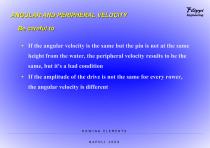
ANGULAR AND PERIPHERAL VELOCITY Filippi Engineering Be careful to • If the angular velocity is the same but the pin is not at the same height from the water, the peripheral velocity results to be the same, but it's a bad condition • If the amplitude of the drive is not the same for every rower, the angular velocity is different
カタログの11ページ目を開く
ANGULAR AND PERIPHERAL VELOCITY Filippi Engineering What we can do We have to check (with data analysis) that the whole crew starts the FORCE (and not the catch) in the same and for the same time, possibly with the same force. In this case the corrections will be little, without very big effort
カタログの12ページ目を開く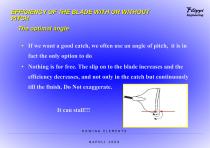
EFFICIENCY OF THE BLADE WITH OR WITHOUT PITCH Filippi Engineering The optimal angle • If we want a good catch, we often use an angle of pitch, it is in fact the only option to do • Nothing is for free. The slip on to the blade increases and the efficiency decreases, and not only in the catch but continuously till the finish. Do Not exaggerate.
カタログの13ページ目を開く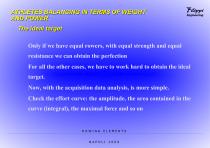
ATHLETES BALANCING IN TERMS OF WEIGHT AND POWER Filippi Engineering The ideal target Only if we have equal rowers, with equal strength and equal resistance we can obtain the perfection For all the other cases, we have to work hard to obtain the ideal target. Now, with the acquisition data analysis, is more simple. Check the effort curve: the amplitude, the area contained in the curve (integral), the maximal force and so on
カタログの14ページ目を開く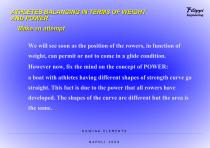
ATHLETES BALANCING IN TERMS OF WEIGHT AND POWER Filippi Engineering Make an attempt We will see soon as the position of the rowers, in function of weight, can permit or not to come in a glide condition. However now, fix the mind on the concept of POWER: a boat with athletes having different shapes of strength curve go straight. This fact is due to the power that all rowers have developed. The shapes of the curve are different but the area is the same.
カタログの15ページ目を開く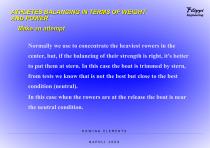
ATHLETES BALANCING IN TERMS OF WEIGHT AND POWER Filippi Engineering Make an attempt Normally we use to concentrate the heaviest rowers in the center, but, if the balancing of their strength is right, it's better to put them at stern. In this case the boat is trimmed by stern, from tests we know that is not the best but close to the best condition (neutral). In this case when the rowers are at the release the boat is near the neutral condition.
カタログの16ページ目を開く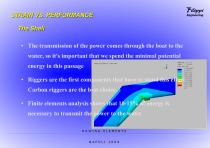
The Shell • The transmission of the power comes through the boat to the water, so it's important that we spend the minimal potential energy in this passage • Riggers are the first components that have to stand this effort. Carbon riggers are the best choice. • Finite elements analysis shows that 10-15% of energy is necessary to transmit the power to the water ROWING
カタログの17ページ目を開く
WEIGHT INFLUENCE Various tests with Kimè (Laura Milani's degree) We have tested with the same boat one rower using 100Kg force and than 125Kg, 150Kg, 200Kg As results: force increase 25% velocity increase 15,3% force increase 50% velocity increase 24,6% ROWING
カタログの18ページ目を開くFilippiのすべてのカタログとパンフレット
-
FILIPPI MOULDS
1 ページ
-
Filippi catalog 2019
36 ページ
-
RACING ROWING BOATS
27 ページ
-
The blade pitching
24 ページ
-
the oars
24 ページ








